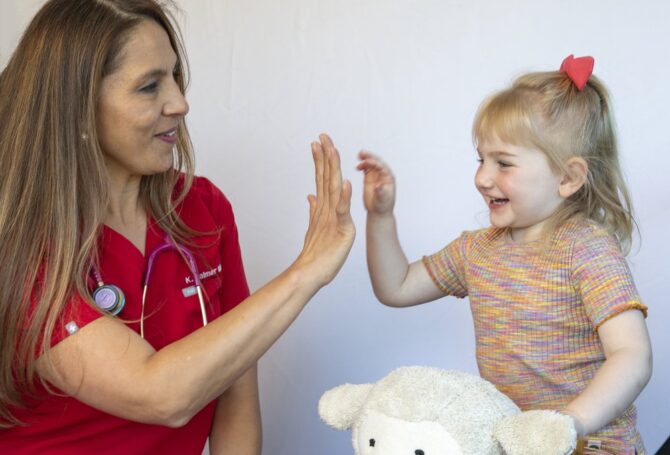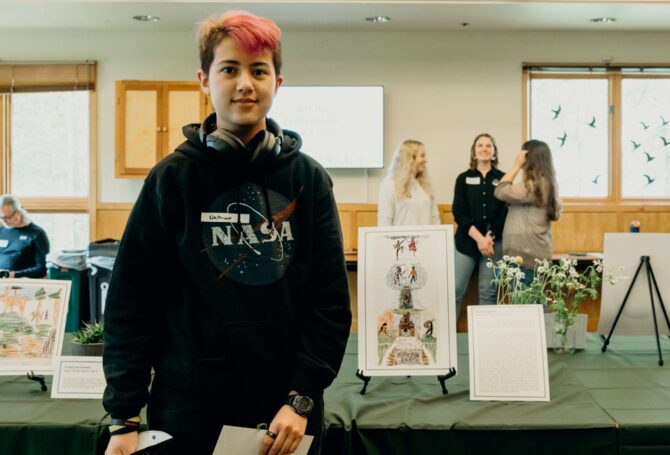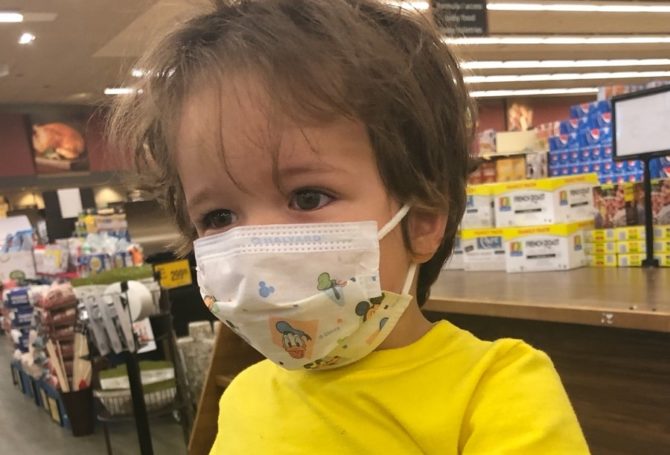
August 11, 2020
5 tips to help your child wear a face mask or covering
To keep Oregonians healthy and safe during the COVID-19 pandemic, wearing face coverings* while in public spaces is required for children over 5 years of age and recommended for children over the age of 2.** (Oregon.gov) These mandates are also supported by the CDC, which recommends that all children over age 2 wear face coverings when unable to appropriately socially distance. (CDC.gov) This raises the question, why should children wear face masks or coverings? And how do we get kids to actually wear them?
COVID-19 is a virus that is spread primarily through respiratory droplets when people are in close contact (eg. < 6 feet apart). Newer research suggests that the virus may also spread through smaller particles called aerosols. In social situations, it is safer to visit and play outside or in a well-ventilated area so that the air flow can help disperse the virus.
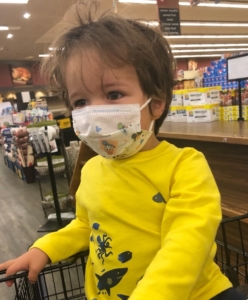
Face masks and coverings can help block the droplets that might be shared when we breathe, talk, sing, sneeze or cough. While children with COVID-19 may not have symptoms (“asymptomatic”) or may not yet show symptoms (“pre-symptomatic”), they can still transmit the virus to others. Therefore, if children are around others without face masks, they could unintentionally spread COVID-19. Research also suggests that when people wear masks, they protect themselves from inhaling the droplets and becoming infected. So when children wear masks, they help slow the spread of COVID-19, protect themselves, and keep everyone healthy!
Face masks can be particularly challenging for toddlers and young children until they become used to wearing them. As we all make the transition to mandatory mask wearing, here are 5 tips to help toddlers and young children ease into consistently wearing face coverings.
1. Start early
As all parents know, routine changes for young children are difficult. Wearing a face mask is no different. Much like brushing their teeth, the best chance for children’s success is to take a slow, step wise approach. Introduce masks well ahead of when you think your child will be required to wear them. Consider starting by simply having masks around the home and pointing out their presence. Next steps can be encouraging children to touch, explore, and play with the masks.
2. Make it familiar
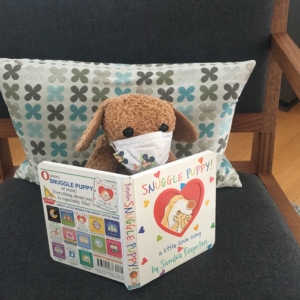
Children are curious by nature. The more that face masks are present in their every-day-life, the more likely children are to explore them without being pressured to do so. Having parents or older siblings wear masks is a great way to model their use, as well as getting younger children interested in wearing them. Putting face masks on favorite dolls or stuffed animals can also encourage young children to actively seek out wearing masks themselves.
3. Make it fun
Given the widespread use of face masks, fun and fashionable designs are becoming increasingly common. Oregon already has many local businesses producing and selling reusable face masks. Allowing your little one to select their face mask is empowering and gives them a sense of control. Consider having multiple masks and allowing your child to choose which mask to wear each day.
While you are choosing a mask, keep the following in mind:
- Not all cloth masks are the same. Try a few different cloth materials, shapes, and styles. Your child might find one particular mask is more comfortable than another mask
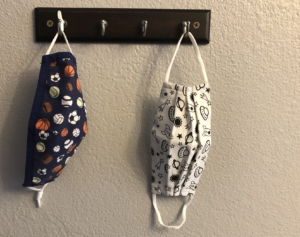
- Cloth masks and coverings should be thick enough that when you hold them up to the light, they are not see-through
- Make sure the face covering covers both the nose and mouth
- Be careful to only touch the ear loops or ties when removing a mask, fold the outside corners together, and then wash hands
- Disposable masks should be discarded after use, cloth masks and coverings should be washed with hot water and dried with high heat or air dried in direct sunlight if possible
- Store reusable masks in paper or plastic bags or hang up for later use
4. Be honest
While young children may not be able to understand the details of COVID 19, they are generally able to comprehend general concepts such as health and safety. When children know the reason for doing something, they are much more likely to be willing to accept the practice. We do this every day with activities such as putting on sunscreen. Comments such as “Time to put on sunscreen so our skin is safe in the sun,” can be adapted to “Okay, time to put our mask on to make sure we all stay safe.”
While promoting honesty, it is important that this honesty not be used as a threat for children to wear masks. Try to keep comments positive and encouraging!
5. Be consistent
Once a child is comfortable wearing a mask, it is important to be consistent with where and when masks are worn. Consistency is the key to habit forming behaviors. Easy places to start are everywhere outside the home (“Whenever we go inside somewhere that is not our home, we wear a mask”) or every time entering an indoor public space (“Okay, we’re going inside now, time to put on our mask.”) It may take some time for children to adapt to wearing a face mask. Be persistent, and use encouraging and positive language. Consider using a reward system to reinforce behaviors.
Teaching toddlers and children to wear masks is not easy, but with time, patience, and encouragement regular mask wearing will become a healthy habit!
8/11/20
** The terms ‘face masks’ and ‘coverings’ will be used interchangeably in this article.
**For safety reasons, children under age 2 should not wear masks.
Robert McRae, MD, is a second year resident at OHSU’s Doernbecher Children’s Hospital.
Joanna Odenthal, MD, is a first year resident at OHSU’s Doernbecher Children’s Hospital.
Ellen Stevenson, MD, MPH, is a pediatrician and Professor of Pediatrics at Oregon Health and Science University.


